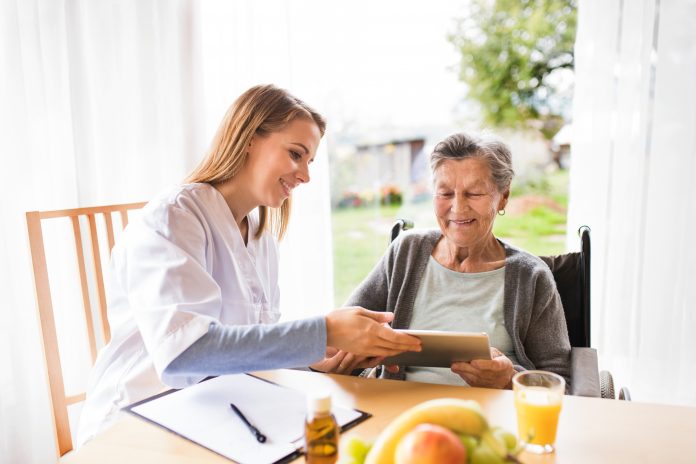Every time we turn on the TV there’s some story about a new technology, gadget or breakthrough. Some are funny, like the app that adds animal noses and ears to human faces on a cell phone, and some are truly groundbreaking, like a device for those with diabetes that can monitor glucose levels without drawing blood. Technology makes life better and sometimes even more fun.
Caregiving is not often seen as a fun activity, but technology can allow caregivers more time to enjoy a little “me” time or even streamline their caregiving duties. Here are some technology ideas that, as a caregiver, you can add in to your routine to make caregiving less stressful:
1. GPS trackers for loved ones.
Whether you place a tracker on a vehicle or a person, they can be lifesavers. Today, technology allows caregivers to place devices on loved ones’ cars, on their walkers, on their wrist or as a necklace, so that you can access their whereabouts on your smartphone. With geo-fencing technology, caregivers can also create a digital fence that alerts when a loved one crosses that threshold. This way, caregivers can immediately know when a loved one travels outside of their safe zone, and it also allows caregivers to see on a map where their loved one is. It’s not a substitute for being careful and attentive to your loved one’s location, but as a back-up, trackers can help keep a wandering loved one from dangerous situations.
2. Telehealth doctor visits.
Today, these types of appointments are more popular than ever, and with a push toward telehealth appointments due to COVID-19 concerns, this will probably continue and possibly even replace many types of office visits. What’s great about this is that the doctors are happy to offer telehealth appointments because it’s less hassle for them, and as a caregiver, it cuts down on the time you previously spent driving your loved one back and forth to doctor visits. It’s also easier to get appointments, plus loved ones will feel more comfortable talking with their providers from the comforts of home.
3. Photo sharing apps and devices.
These types of devices have come a long way since the early days. These are especially fun for an older loved one who is not computer savvy, as many older adults are not able to manage the complexities of running a computer. These devices allow family members to share photos from their phones to a screen located in a loved one’s home. Loved ones can look at the screen and can see images from family and friends almost as quickly as sharing photos via text or Facebook, without the hassle of keeping a computer running (or constantly fixing minor issues due to a loved one’s lack of computer skills). The best part is the ability to add captions and notes to the photos so your loved one can see those on the screen too.
4. Medical alert and fall buttons.
These have also been around for a while, but technology continues to add improvements. Now, many medical alert buttons have two-way speakers so if a loved one gets lost or falls down, they push a button on their wrist or necklace device and an operator will ask them questions through a speaker on the device. Some of these devices have a GPS tracker on them as well, so if police need to be called, a loved one can be located very quickly. The only issue with these devices is that they need to be worn in order to work. So, it’s crucial that caregivers work with their loved ones to make sure the devices are worn at all times. Some are water-proof and can be worn in the shower, so if a loved one falls while bathing, they can still push a button to alert their loved one or an operator from the device’s service program.
5. Automated medication or pill dispensers.
The technology is improving as we speak, but for caregivers who are not able to be present every time a loved one needs a medication, these devices are invaluable. Medications will still need to be placed into the dispenser by a caregiver or medical professional, but once the pills are deposited into the device, an automated system will deliver the pills into the receptacle at the appointed time of day. Some can be programmed to chime or give alerts so a loved one knows when to take his or her pills. There are many versions available, so it pays to try a few out to see what works best for you and your loved one.
For those caregivers who are security-conscious and willing to do a little work, The New York Times listed some of the best home security devices for seniors here. Installation can be tricky, but many also offer installation for a fee. Technology is changing at a rapid pace, especially in the caregiving space. Caregivers can now use technology to make their caregiving journey a little less stressful, and maybe even a little more fun.























